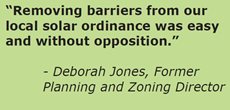Falcon Heights
Encouraging Solar by Removing Obstacles in the Local Ordinance
The updated ordinances also provide for standards for setback, height, visibility, and location. The resulting solar ordinance update was unanimously approved and without opposition. These small changes made a big difference in helping to successfully implement solar in the City.
What may help other communities?
Good Resources

The City described the process of removing obstacles from their solar ordinance as being easy and without conflict. Part of this was due to the valuable resources and support provided through the Minnesota Solar Energy Challenge, including a model solar ordinance. The City used the model solar ordinance as a guide to determine which updates were needed. In addition, they reviewed solar ordinance of neighboring communities and evaluated the updates to make sure the changes didn’t create unintended conflicts. When developing the updated ordinance, Falcon Heights found that it was important to have good definitions, including for active and passive solar systems.
Education/Opportunities
To encourage solar installations, the City hosted workshops to share information about solar resources. These workshops were in partnership with the MetroClean Energy Resource Team . The workshops discussed basics of solar power systems, provided tools and information about incentives and rebates, and discussed common misperceptions. The workshops also included a panel of people that discussed how solar has worked for them, which included the Mayor. To provide additional opportunities for solar, the City ensured a reasonable permit fee and signed up for a discount program that makes solar more affordable for its homeowners. The City has also been researching ways for residents in areas of limited solar access to participate in a cooperative solar garden.
Partnerships/Participation
Partnerships and participation with Green Step Cities, Regional Indicators Initiative (RII), and B3 Benchmarking all contribute to the comprehensive plan’s goal of adopting and encouraging best practices for energy efficiency and environmental sustainability. Falcon Heights was one of the pilot cities for Minnesota GreenStep Cities, which helps cities achieve sustainability goals through of best practices focused on cost savings, energy use reduction, and innovation. Falcon Heights was also pilot city for RII, which measures annual performance metrics for 22 Minnesota cities committed to increasing their overall efficiency and level of sustainability. The City also participates in the State of Minnesota’s B3 Benchmarking, which is an energy tracking, benchmarking, and reporting system developed to help manage, improve, and monitor the energy efficiency of existing public buildings.
Awards and Recognitions
Contact the City of Falcon Heights
Sack Thongvanh, City Administrator, (651) 792-7611, [email protected]
More solar resources are linked here.
Printable PDF